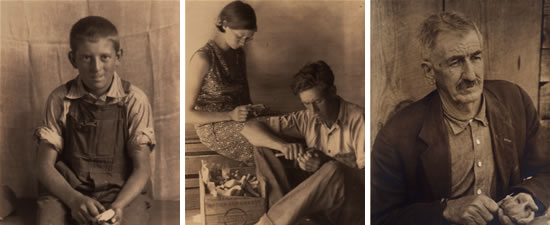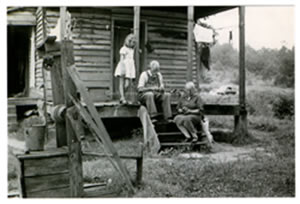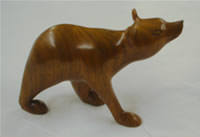Woodwork:
Carving
The Craft Revival drew on traditional forms of creative expression while adapting them to new markets. In Appalachia, carvers used pocket knives to shape scraps of wood into figures, often dolls and toys for their children. The Pleasant Hill Academy in Tennessee taught carving to young school children, but in most other places, carving was serious business. As tourism brought markets within the reach of mountain families, carving became an important source of income. In western North Carolina, successful carving centers developed in Cherokee, Asheville, Tryon, and Brasstown.
Cherokee was home to many celebrated carvers. Seaborn Bradley was known for taking home prizes from the annual Cherokee Indian Fair. Born in 1907 in the Big Cove community, Bradley made and displayed war clubs, tomahawks, and walking sticks. Will West Long, a traditional medicine man, made masks used in native celebrations. His son, Allen Long learned to carve at the age of twelve. Born in 1917 in the Big Cove community, Allen Long made a variety of masks, all of which had special meaning to Cherokee ceremonies. Another artisan from the Big Cove community was Hayes Lossiah. Born in 1905, Lossiah was skilled in the art of making traditional Cherokee objects: blowguns, darts, bows, and arrows. He won many awards at the Cherokee Fair and worked for 40 years at the Oconaluftee Indian Village explaining his craft to visitors. The roster of skilled Cherokee carvers included Posey Long, John Wahnetah, and Adam Welch. Two of the most celebrated carvers from Cherokee were Goingback Chiltoskey and Amanda Crowe. Their work took each of them to the Chicago Art Institute where they studied a broad range of art forms. Both Chiltoskey and Crowe became celebrated teachers and influenced subsequent generations of Cherokee artisans.
Eleanor Vance and Charlotte Yale established two woodworking centers in western North Carolina. Vance was born in Ohio and studied woodworking at the School of Design in Cincinnati. Attending the Moody Bible Institute in Chicago, Vance met fellow student Charlotte Yale. In 1901 the two women came south to Asheville, most likely as missionaries. After settling in Biltmore Village, Vance and Yale organized an informal boys’ club under the auspices of a local church. With funding from Edith and George Vanderbilt, Vance and Yale’s operation was formalized in 1905 as the Biltmore Estate Industries on the grounds of the Biltmore estate. Production focused on carving; later homespun weaving was added. In 1915 Vance and Yale moved 40 miles south of Asheville to establish Tryon Toy-Makers and Wood-Carvers. George Arthur, who began to work with Vance and Yale as a teen, remained a woodworker with Biltmore until the operation was sold in 1917. Arthur set up his own Artisans Shop in nearby Biltmore Forest.
Several carvers in and around Brasstown were pictured in Allen Eaton’s 1937 study of regional handicrafts. Eaton characterized William Julius “W. J.” Martin as “one of the eldest in years but among the youngest in spirit.” Martin is shown with a carving of a wild turkey made of apple wood. Floyd Laney became known for carving “mad” mules, an animal form that has been passed down among carvers who produce work for the John C. Campbell Folk School. Another early Brasstown carver was Nina Bryant, who worked in the school’s kitchen. In the early 1930s women rarely were part of the Brasstown carving cooperative; later, the number of women outpaced the number of men. Hayden Hensley began carving in 1930 when he was student at the folk school. He and others carved with Parker Fisher, who taught at the school from 1930 until 1934 or 1935. Other carvers who worked with Parker Fisher included Gwen Cornwell, William “Gyp” Johnson, and a young Quentin Clayton.

In communities in and around Brasstown, carving was an activity that cut across generations and gender
In 1935 the John C. Campbell Folk School hired Murrial Galt, a graduate of the Maryland Institute of Art and an occupational therapist, to teach crafts at the school. Within a few years, she married W. J. “Dub” Martin, grandson of the elder carver. Murrial Galt Martin, known as “Murray,” was an exacting teacher. She scrutinized each carving before accepting it for purchase by the folk school. Ben Hall and Hope and Glenn Brown were among the first carvers to work with Martin. The Hall family included a number of well-known carvers. Brothers Ben, John, and Elisha Allen Hall carved; Ben’s son, Jack Hall, assisted with the carving program. Martha Coffey, Ray Mann, Dexter and Hazel Dockery, Janice Anderson, Christine Gilbert, and Helen Gibson all carved under Jack Hall. Gibson took over as resident carver when he left the folk school. Other well-known carvers included J. A. Morris, Nolan Beaver and his sister Carmen Beaver Fleming, Doris “Dot” Reece, Ruth Fleming Hawkins, and Sue McClure. Herman and Mabel Estes also worked in wood, but they made mostly functional items, like serving platters, rather than the animal carvings that were so popular among Brasstown carvers. The carvers took on the formal name of “Brasstown Carvers” in the 1950s and today continue to make signature items that include small, highly polished animals and a variety of figures that make up the nativity scene.





